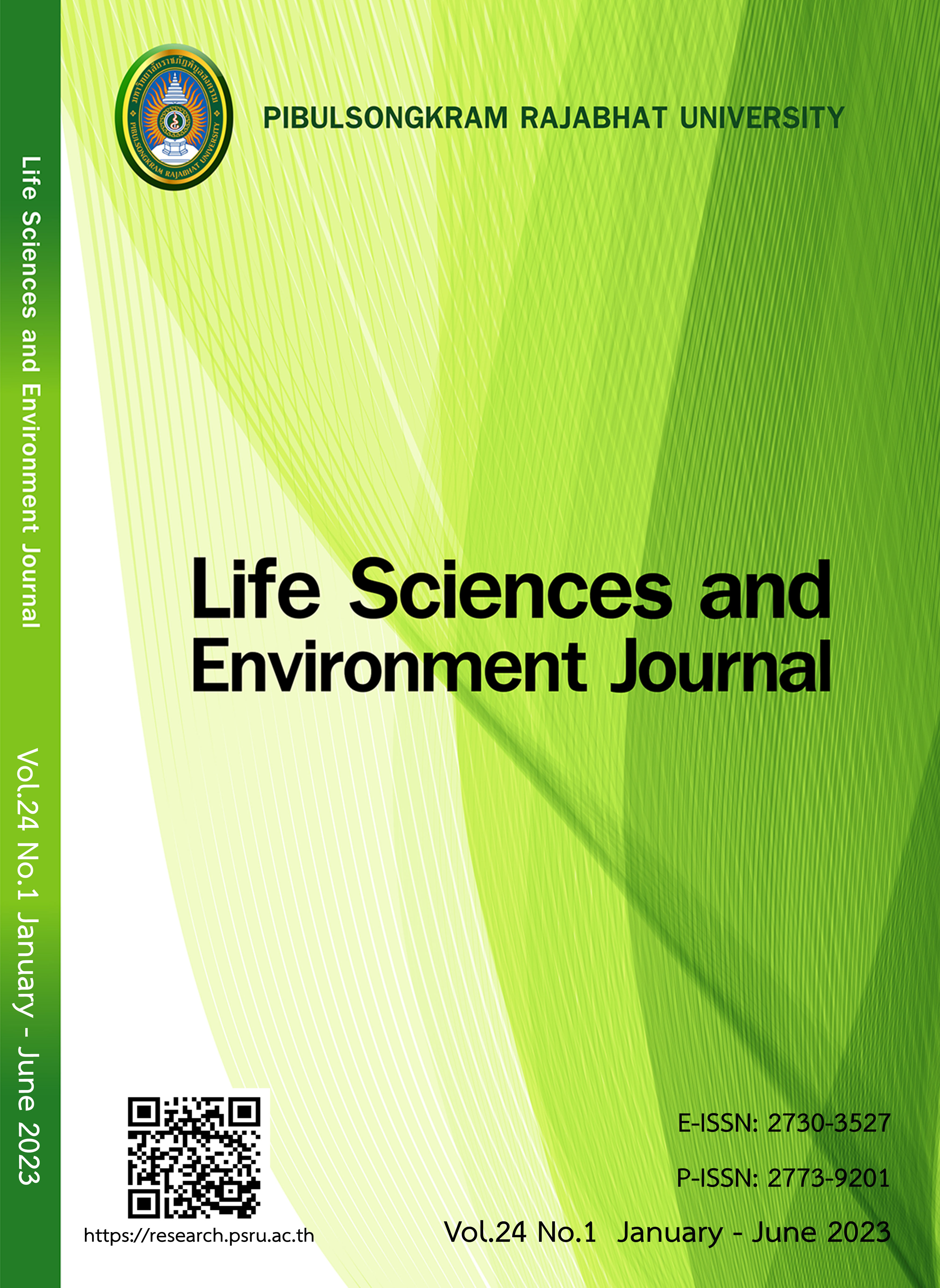A STUDY ON YEAST CULTURE FROM RESIDUE OF DRIED BANANA FOR USING AS FEED SUPPLEMENT
DOI:
https://doi.org/10.14456/lsej.2023.10Abstract
This research aimed to study the yeast culture from the dried banana residue for use as a feed supplement. Yeast culture was carried out from the residue of dried banana and mixed with distilled water in a total ratio of 5 treatments such as 1:2, 1:4, 1:6, 1:8 and 1:10, respectively. Each mixture (100 g) was mixed with 1 g baker yeast (Saccharomyces cerevisiae) and incubated in a 100 rpm shaken bath at 30°C for 72 hours. Afterwards, yeast cultures obtained by using the spread plate technique were counted. The results showed that the number of yeast was increased when the water ratio increased. Yeast culture from the residues of dried banana mixed with distilled water at a ratio of 1:10 showed the greatest number of yeast production and followed by 1:8 (6.10 × 107 cfu/g), 1:6 (5.40 × 107 cfu/g), 1:4 (4.80 × 107 cfu/g) and 1:2 (7.34 × 106 cfu/g), respectively. The current study concluded that the mixture of dried banana residues and distilled water at a ratio of 1:10 could increase the highest number of yeast. This process may be one approach for increasing the value added and utilization of agricultural waste due to producing live yeast for a feed supplement in the future.
References
AOAC. Official Methods of Analysis of AOAC International. USA: Gaithersburg, MD, AOAC International; 2016.
Baylis D. Griffin M. Growth and Its Measurement in Plants and Animals. Bio Factsheet, 2015. Available at: http://www.moodle. Itchen.ac.uk. Accessed January 20, 2023.
Cheeke PR. Applied Animal Nutrition; Feed and Feeding. New York: Mcmillian Publishing Company; 1999.
Doyle E. Alternative to antibiotic use for growth promotion in animal husbandry. Madison: University of Wisconsin-Madison; 2007.
Fankhauser DB. Yeast plate count protocol, 2012. Available at: http://biology.clc.uc.edu/fankhauser/ Labs/Microbiology/Meat_Milk/Pour_Plate.htm. Accessed September 10, 2022.
Incharoen T, Laorodpun N, Treetan S, Khoktean W. Influence of dietary fermented banana peel with yeast on egg performance and quality of laying ducks. Khon Kaen Agricultural Journal 2016;44(1):432-436.
Khamterm P. Investigation of compost production from banana peels. Master of Science in Chemistry, Naresuan University; 2004.
Khumnok C. Yeast…..Industrial microorganisms. Life Sciences and Environment Journal 2007;8(1-2):84-90.
Limsiriwong S. The development of guidelines for a sustainable production of dried banana in Bangkatum district, Phitsanulok. Journal of Community Development Research (Humanities and Social Sciences) 2020;11(1):141-150.
Mathew AG, Chattin SE, Robbins CM, Golden DA. Effects of a direct-fed yeast culture on enteric microbial populations, fermentation acids, and performance of weanling pigs. Journal of Animal Science 1998;76:2138-2145.
Moonsarn Y, Moonsarn P. Improvement of noodle waste by yeast for use as animal feed. Life Sciences and Environment Journal 2011;12(2):1-17.
Mopoung S. Boonphong S. Mopoung R. Udeye V. (The production of charcoal and activated carbon from peels and bunch stalk of banana, 2006. Available at: https://webkc.dede.go.th/testmax/ sites/default/files.pdf. Accessed October 1, 2022.
Namwong S. Roesjanaperapong S. Effect of using yeast fermented cassava pulp on the growth of Muscovy ducks. Institute of Vocational Education Southern Region 1 Journal. 2020;5:93-99.
Nanasombat S. Waste of dried bananas and begging to control those relatives. graduate school, Kasetsart University;1991:138.
Oyedeji JO, Ajayi HI, Egere T. The effects of increasing levels of yeast culture (Levucel SB) in a high fibre-diet on the performance and nutrient retention of broiler chicks. Asian Journal of Poultry Science 2008;2:53-57.
Pojun S, Pojun P, Wanasitchaiwat V. Wanasitchaiwat. Effect of yeast culture as feed supplement on performance of commercial layers, 2004. Available at: http://nutrition.dld.go.th/Research%20Report 53-55/Research_Knowlage/RESEARCH/research_full/2547/R4718.pdf. Accessed October 1, 2022.
Suh KJ, Hong YS, Skirda VD, Volkov VI, Lee CY, Lee CH. Water self-diffusion behavior in yeast cells studies by pulsed field gradient NMR. Biophysical Chemistry 2003;104:121-130.
Suksombat W. A live yeast in dairy cattle feed. Journal of dairy cattle 1989;9(4):22-24.
Tangtaweewipat S, Cheva-Isarakul B, Maneethong N, Jantarapaoraya V. Use of Cultivated Banana as Jelly Feed for Pre-weaning Piglets. Institute for Small and Medium Enterprises Development (ISMED). 2016.
Tartrakoon T, Chalermsan N, Vearasilp T, Meulen U. The nutritive value of banana peel (Musa sapieutum L.) in growing pigs. Deutscher Tropentag 1999 in Berlin, Session: Sustainable Technology Development in Animal Agriculture. Thongpoon C. Determination of food additives in dried banana products. Full research report Department of Chemistry Faculty of Science and Technology Rajabhat Institute Pibulsongkhram. 1997; 61.
Wang JP, Kim JD, Kim JE, Kim IH. Amino acid digestibility of single cell protein from Corynebacterium ammoniagenes in growing pigs. Animal Feed Science and Technology 2013;180:111-114.
Zepka LQ, Jacob-Lopes E, Goldbeck R, Souza-Soares LA, Queiroz MI. Nutritional evaluation of single-cell protein produced by Aphanothece microscopica Nageli. Bioresour. Bioresource Technology 2010;101(18):7107-7111.
Zhang HY, Piao XS, Li P, Yi JQ, Zhang Q, Li QY, Liu JD. et al. Effects of single cell protein replacing fish Meal in diet on growth performance, nutrient digestibility and intestinal morphology in weaned pigs. Asian Australas. Journal of Animal Science 2013;26:1320-1328.
Downloads
Published
How to Cite
Issue
Section
License
Copyright (c) 2023 Life Sciences and Environment Journal

This work is licensed under a Creative Commons Attribution-NonCommercial-NoDerivatives 4.0 International License.
Each article is copyrighted © by its author(s) and is published under license from the author(s).










